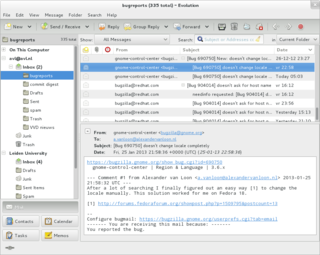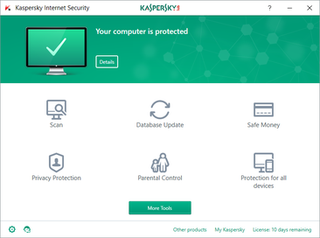
Email is a method of transmitting and receiving messages using electronic devices. It was conceived in the late–20th century as the digital version of, or counterpart to, mail. Email is a ubiquitous and very widely used communication medium; in current use, an email address is often treated as a basic and necessary part of many processes in business, commerce, government, education, entertainment, and other spheres of daily life in most countries.

Spamming is the use of messaging systems to send multiple unsolicited messages (spam) to large numbers of recipients for the purpose of commercial advertising, non-commercial proselytizing, or any prohibited purpose, or simply repeatedly sending the same message to the same user. While the most widely recognized form of spam is email spam, the term is applied to similar abuses in other media: instant messaging spam, Usenet newsgroup spam, Web search engine spam, spam in blogs, wiki spam, online classified ads spam, mobile phone messaging spam, Internet forum spam, junk fax transmissions, social spam, spam mobile apps, television advertising and file sharing spam. It is named after Spam, a luncheon meat, by way of a Monty Python sketch about a restaurant that has Spam in almost every dish in which Vikings annoyingly sing "Spam" repeatedly.
A whitelist or allowlist is a list or register of entities that are being provided a particular privilege, service, mobility, access or recognition. Entities on the list will be accepted, approved and/or recognized. Whitelisting is the reverse of blacklisting, the practice of identifying entities that are denied, unrecognised, or ostracised.
Various anti-spam techniques are used to prevent email spam.

The Controlling the Assault of Non-Solicited Pornography And Marketing (CAN-SPAM) Act of 2003 is a law passed in 2003 establishing the United States' first national standards for the sending of commercial e-mail. The law requires the Federal Trade Commission (FTC) to enforce its provisions. Introduced by Republican Conrad Burns, the act passed both the House and Senate during the 108th United States Congress and was signed into law by President George W. Bush in December 2003 and was enacted on January 1, 2004.

Email spam, also referred to as junk email, spam mail, or simply spam, is unsolicited messages sent in bulk by email (spamming). The name comes from a Monty Python sketch in which the name of the canned pork product Spam is ubiquitous, unavoidable, and repetitive. Email spam has steadily grown since the early 1990s, and by 2014 was estimated to account for around 90% of total email traffic.
A Joe job is a spamming technique that sends out unsolicited e-mails using spoofed sender data. Early Joe jobs aimed at tarnishing the reputation of the apparent sender or inducing the recipients to take action against them, but they are now typically used by commercial spammers to conceal the true origin of their messages and to trick recipients into opening emails apparently coming from a trusted source.
Internet security is a branch of computer security. It encompasses the Internet, browser security, web site security, and network security as it applies to other applications or operating systems as a whole. Its objective is to establish rules and measures to use against attacks over the Internet. The Internet is an inherently insecure channel for information exchange, with high risk of intrusion or fraud, such as phishing, online viruses, trojans, ransomware and worms.
A bounce message or just "bounce" is an automated message from an email system, informing the sender of a previous message that the message has not been delivered. The original message is said to have "bounced".
Norton Internet Security, developed by Symantec Corporation, is a discontinued computer program that provides malware protection and removal during a subscription period. It uses signatures and heuristics to identify viruses. Other features include a personal firewall, email spam filtering, and phishing protection. With the release of the 2015 line in summer 2014, Symantec officially retired Norton Internet Security after 14 years as the chief Norton product. It was superseded by Norton Security, a rechristened adaptation of the original Norton 360 security suite. The suite was once again rebranded to Norton 360 in 2019.
SpamCop is an email spam reporting service, allowing recipients of unsolicited bulk or commercial email to report IP addresses found by SpamCop's analysis to be senders of the spam to the abuse reporting addresses of those IP addresses. SpamCop uses these reports to compile a list of computers sending spam called the "SpamCop Blocking List" or "SpamCop Blacklist" (SCBL).
Spam Cube, Inc was a high-tech startup company based in the midtown area of New York City. The company invented and manufactured the Spam Cube, a SaaS network security hardware device for consumers that blocked spam e-mail, computer viruses and phishing. The company invented a SaaS delivery platform technology that enables any home networking embedded device such as a Broadband cable modem, DSL modem, Wireless router or Femtocell to offer network Security As A Service technology that blocks spam e-mail, computer viruses and phishing. The Spam Cube SaaS platform gave the consumer the choice to select spam e-mail, computer viruses, and phishing blocking technology that was powered by either McAfee or Symantec managed enterprise Security As A Service technology.

Kaspersky Internet Security is a internet security suite developed by Kaspersky Lab compatible with Microsoft Windows and Mac OS X. Kaspersky Internet Security offers protection from malware, as well as email spam, phishing and hacking attempts, and data leaks. Kaspersky Lab Diagnostics results are distributed to relevant developers through the MIT License.
Backscatter is incorrectly automated bounce messages sent by mail servers, typically as a side effect of incoming spam.
Brightmail Inc. was a San Francisco–based technology company focused on anti-spam filtering. Brightmail's system has a three-pronged approach to stopping spam, the Probe Network is a massive number of e-mail addresses established for the sole purpose of receiving spam. The Brightmail Logistics and Operations Center (BLOC) evaluates newly detected spam and issues rules for ISPs. The third approach is the Spam Wall, a filtering engine that identifies and screens out spam based on the updates from the BLOC.

Proofpoint, Inc. is an American enterprise cybersecurity company based in Sunnyvale, California that provides software as a service and products for email security, identity threat defense, data loss prevention, electronic discovery, and email archiving.

A feedback loop (FBL), sometimes called a complaint feedback loop, is an inter-organizational form of feedback by which a mailbox provider (MP) forwards the complaints originating from their users to the sender's organizations. MPs can receive users' complaints by placing report spam buttons on their webmail pages, or in their email client, or via help desks. The message sender's organization, often an email service provider, has to come to an agreement with each MP from which they want to collect users' complaints.
Cyberhound Pty Ltd, is an Australian-owned provider of internet and email security, filtering and management solutions founded in Brisbane by John Oxnam, Justin Cook and Trent Davis in 1999. It is a privately held company. CyberHound's head office is located in Fortitude Valley, Queensland, Australia. The company provides products for internet compliance, management and security.
SmartScreen is a cloud-based anti-phishing and anti-malware component included in several Microsoft products:
A cold email is an unsolicited e-mail that is sent to a receiver without prior contact. It could also be defined as the email equivalent of cold calling. Cold emailing is a subset of email marketing and differs from transactional and warm emailing.






